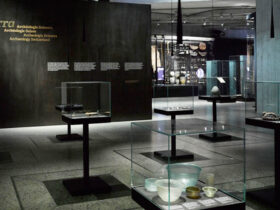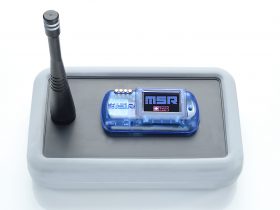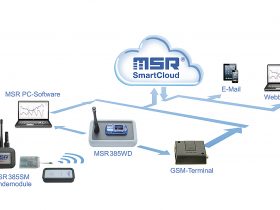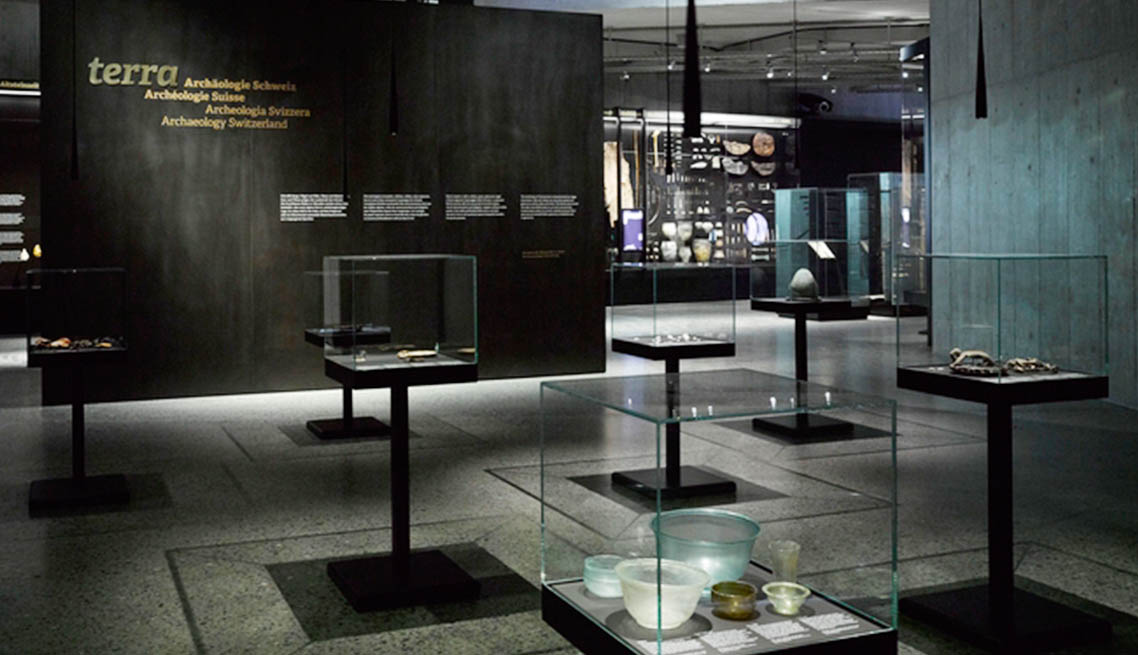
Swiss National Museum: MSR Wireless Data Loggers Monitor Climate Values
Measurement data from the cloud – with MSR385WD wireless data logger
The new building of the National Museum Zurich provides ideal climatic conditions for exhibits; now and then, objects from different material groups have special climatic requirements, therefore continuous monitoring using climate meters is extremely important.
Authors: Dr. Katharina Schmidt-Ott, Head Archaeological Objects, National Museum Zurich and Martin Bader, Archaeological Objects, National Museum Zurich
The permanent archaeological exhibition of the Swiss National Museum was opened in the new building of the National Museum Zurich in August 2016. Here, selected archaeological objects from the museum’s collection and one-off items on loan from all over Switzerland are showcased. The spectrum of these treasures ranges from a Palaeolithic stone hand axe, through wooden arches and golden torcs, to an early medieval, delicate fragment of cloth. Occasionally, the objects from the different groups of material have special climatic requirements. Objects made of organic materials require moderate, stable climatic conditions; they may react to minor fluctuations in humidity with irreparable damage due to the stress in the materials. Objects made of metal are better protected against corrosion if they are exhibited in a dry environment.
The new building of the National Museum offers ideal climatic conditions for exhibits. In order to optimally adjust the climate inside the display cabinets to the exhibits, so-called climate control compartments are used. These compartments are connected with the area containing the exhibit, but they can be accessed separately from the outside. By adding materials that have a passive effect on climate control, such as desiccants, the humidity can be individually adjusted and stabilised. However, potential fluctuations must be identified and rectified quickly; therefore, monitoring by means of climate meters is extremely important.
Mini data loggers monitor climatic values
Measurements of both the indoor and the display cabinet environmental quality have been implemented for some 30 years in the National Museum. Yet, in line with technical advancement, the first mechanical hair hygrometers were replaced by electronic systems in the course of time. In addition to their functionality, the new measurement systems were supposed to be as visually unobtrusive and user-friendly as possible.
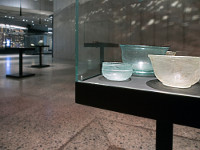 Since 2011, the climate data in the display cabinets is recorded individually using mini data loggers of the type MSR145 by the Swiss measuring technology company MSR Electronics GmbH. Due to the comparatively small measuring heads, this system quickly established itself as inconspicuous measuring equipment. Due to their data memory and battery capacity, the autonomous mini data loggers, which have been equipped with temperature and humidity sensors, facilitate continuous measurements for up to one year. For each exhibition an average of 20 of these measuring devices were used. However, previously the climate control compartments always had to be opened and the data loggers had to be read individually.
Since 2011, the climate data in the display cabinets is recorded individually using mini data loggers of the type MSR145 by the Swiss measuring technology company MSR Electronics GmbH. Due to the comparatively small measuring heads, this system quickly established itself as inconspicuous measuring equipment. Due to their data memory and battery capacity, the autonomous mini data loggers, which have been equipped with temperature and humidity sensors, facilitate continuous measurements for up to one year. For each exhibition an average of 20 of these measuring devices were used. However, previously the climate control compartments always had to be opened and the data loggers had to be read individually.
Cloud solution independent from your location
With the new MSR385WD wireless data logger, the National Museum now uses a radio system that offers greater freedom with respect to the measuring sites and that renders the time-consuming, separate reading of measured values superfluous. Transmission of the measured data via the mobile network facilitates the safe and continuous control of the climatic values. The heart of the system is the MSR385WD data logger. It has an integrated ISM band receiver module through which it receives and stores data from up to ten transmitter modules. Up to ten transmitter modules can be shown simultaneously on the display. The transmitter modules (MSR385SM) in the smallest housing model weigh approximately 25 g and measure a mere 35 x 55 x 25 mm; they can be placed in the climate control compartment of the display cabinet. With a diameter of only 6 mm and a length of 23 mm, the small measuring head is barely visible.
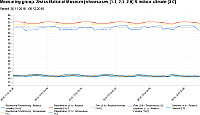 The measured data in the “Archaeology in Switzerland” permanent exhibition is transmitted directly from the transmitter module to a ceiling-mounted receiver (MSR385WD), which is connected to the Internet and which transmits the data to the MSR SmartCloud. This cloud solution managed by MSR Electronics GmbH stores the measured values in a database. Therefore, the current measured values of multiple data loggers can be viewed by authorised personnel via web access. Thus, all desired display cabinets can be controlled through the MSR385WD with a few clicks, wherever you are. The data from different display cabinets can be defined as a group and retrieved collectively. In the case of items on loan, the measured data is put together specifically for the individual loaner. Furthermore, alarm values can be specified for each measuring sensor. If an alarm value is exceeded, a warning is sent by e-mail, enabling the responsible employee to react without delay.
The measured data in the “Archaeology in Switzerland” permanent exhibition is transmitted directly from the transmitter module to a ceiling-mounted receiver (MSR385WD), which is connected to the Internet and which transmits the data to the MSR SmartCloud. This cloud solution managed by MSR Electronics GmbH stores the measured values in a database. Therefore, the current measured values of multiple data loggers can be viewed by authorised personnel via web access. Thus, all desired display cabinets can be controlled through the MSR385WD with a few clicks, wherever you are. The data from different display cabinets can be defined as a group and retrieved collectively. In the case of items on loan, the measured data is put together specifically for the individual loaner. Furthermore, alarm values can be specified for each measuring sensor. If an alarm value is exceeded, a warning is sent by e-mail, enabling the responsible employee to react without delay.
The advancement of the MSR data loggers with wireless sensors has made climate control in the Swiss National Museum significantly easier. In addition to being used in the permanent archaeological exhibition, the system is also increasingly being used for the temporary exhibitions featuring top-class items on loan.
These pages might also be of interest to you:
- Configure your individual MSR385WD wireless measuring system!
- Product overview data loggers for museums
- Product overview data loggers for climate monitoring
- CTI project: Preventation strategies for the transport of fragile paintings
- Wireless data logger MSR385WD monitors temperature at wind turbine gearboxes in China
 Deutsch
Deutsch

